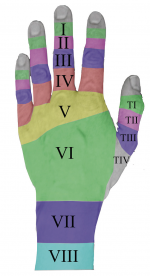Extensor Tendon Injuries of the Hand: Difference between revisions
No edit summary |
No edit summary |
||
| Line 24: | Line 24: | ||
== Epidemiology /Etiology == | == Epidemiology /Etiology == | ||
The extensor tendons of the hand are located superficially, so they are very susceptible to injuries. An-other reason is the lack of subcutaneous tissue between the tendons and the overlying skin<ref>Saini N. et al. Outcome of early active mobilization after extensor tendon repair. Indian J Orthop 2008; 42(3): 336-341 (level B)</ref>. Possible mechanisms are sharp object direct lacerations, burns, blunt trauma, bites, crush injuries, avulsions and deep abrasions<ref>Pho C, Godges J. Extensor tendon repair and rehabilitation (level F)</ref>. Closed injuries arise usually under situations of extreme load. This results in ripping the tendons apart from their attachment of the bone.<br> | |||
== Characteristics/Clinical Presentation == | == Characteristics/Clinical Presentation == | ||
Revision as of 11:55, 7 March 2012
Original Editors
Lead Editors - Your name will be added here if you are a lead editor on this page. Read more.
Search Strategy[edit | edit source]
Key words: extensor tendon injury, extensor tendon mechanism NOT surgery, hand, wrist, extensor tendon lacerations, rehabilitation, immobilisation AND extensor tendon injury, treatment AND extensor tendon injury NOT surgery
Search engines: Pubmed, Web of knowledge, Pedro, VUB library, google books (can be useful)
Definition/Description[edit | edit source]
An extensor tendon injury is a cut or tear to one of the extensor tendons. Due to this injury, there is an inability to fully and forcefully extend the wrist and/or fingers.
Clinically Relevant Anatomy[edit | edit source]
Extensor tendons are located at the dorsal region of the hand and fingers. The function of these tendons is to extend the wrist and the fingers. According to Kleinert and Verdan (1983), there are eight anatomic zones in which the extensor mechanism is divided[1] :
Zone I: DIP joint
Zone II: middle phalanx
Zone III: PIP joint
Zone IV: proximal phalanx
Zone V: MCP joint
Zone VI: metacarpals
Zone VII: wrist (carpus and extensor retinaculum)
Zone VIII: distal third of the forearm[2]
Epidemiology /Etiology[edit | edit source]
The extensor tendons of the hand are located superficially, so they are very susceptible to injuries. An-other reason is the lack of subcutaneous tissue between the tendons and the overlying skin[4]. Possible mechanisms are sharp object direct lacerations, burns, blunt trauma, bites, crush injuries, avulsions and deep abrasions[5]. Closed injuries arise usually under situations of extreme load. This results in ripping the tendons apart from their attachment of the bone.
Characteristics/Clinical Presentation[edit | edit source]
add text here
Differential Diagnosis[edit | edit source]
add text here
Diagnostic Procedures[edit | edit source]
add text here related to medical diagnostic procedures
Outcome Measures[edit | edit source]
add links to outcome measures here (also see Outcome Measures Database)
Examination[edit | edit source]
add text here related to physical examination and assessment
Medical Management
[edit | edit source]
add text here
Physical Therapy Management
[edit | edit source]
add text here
Key Research[edit | edit source]
add links and reviews of high quality evidence here (case studies should be added on new pages using the case study template)
Resources
[edit | edit source]
add appropriate resources here
Clinical Bottom Line[edit | edit source]
add text here
Recent Related Research (from Pubmed)[edit | edit source]
see tutorial on Adding PubMed Feed
Extension:RSS -- Error: Not a valid URL: Feed goes here!!|charset=UTF-8|short|max=10
References[edit | edit source]
see adding references tutorial.
- ↑ Brotzman S.B., Manske R.C. Clinical Orthopaedic Rehabilitation: An Evidence-Based Approach, Elsevier Health Sciences, 2011
- ↑ Matzon JL, Bozentka DJ. Extensor tendon injuries. J Hand Surg 2010; 35A: 854-861. (levelB)
- ↑ Milner C., Russell P. Focus on extensor tendon injury. British Editorial Society of Bone and Joint Surgery 2011 (level E)
- ↑ Saini N. et al. Outcome of early active mobilization after extensor tendon repair. Indian J Orthop 2008; 42(3): 336-341 (level B)
- ↑ Pho C, Godges J. Extensor tendon repair and rehabilitation (level F)







